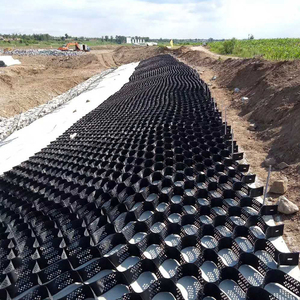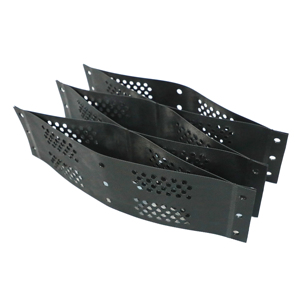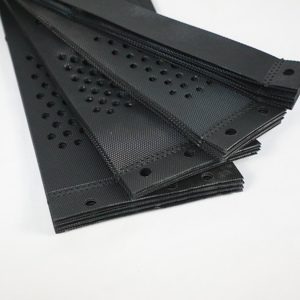(6256 products available)
















































































































































































































Geotextiles for slope protection are fabrics that are used to protect slopes against soil erosion and landslides. These geotextiles are used as reinforcements to hold soil firmly and prevent it from being washed away by water. The fabrics can be made from different materials like polypropylene, polyester, and polyethylene.
Geotextile slope protection comes in different types, including:
Geosynthetic slope protection prevents soil erosion by shielding the soil from the impact of rainfall and surface runoff. Without the geotextile, the soil would be washed away by the force of the water. The geotextile allows the water to flow through it while trapping the soil particles.
Geotextile stabilizes soil particles by providing a barrier that keeps the soil in place during heavy rain and floods. It helps the slope keep its shape and prevent landslides. The geotextile is like a blanket that holds the soil together. It also prevents debris from falling onto the road below.
Geotextiles reinforce the structure by adding strength and stability, which enables them to support more weight. By reinforcing the slope with geotextile, it is possible to build steeper slopes. This is important for highways and railroads that need to be built on hills and mountains.
Geotextiles allow water and air to pass through, which helps prevent water from pooling on the slope and causing flooding. It also allows the roots of plants to grow through the geotextile, which helps anchor the soil. This is important for preventing soil erosion during heavy rain and winds.
Some geotextiles are treated with antioxidants and UV stabilizers, which protect them from damage caused by the sun's UV rays and other environmental factors. This increases their lifespan and makes them more durable.
Geotextiles are lightweight and easy to handle, which makes them easy to install. This is important because it reduces the time and cost of construction projects. They can also be cut to fit the size of the slope, which makes installation simple and quick.
Geotextiles require little to no maintenance once installed. This is because they are durable and long-lasting. This saves time and money for the owner of the slope. Low maintenance also means that the slope does not have to be closed for repairs, which is important for highways and railroads.
Geotextiles are commonly used in protecting slopes around housing estates and commercial buildings. They offer stability to the soil on steep slopes near roads, parking lots, and structures. This ensures the safety of people and property from soil erosion and landslides. Additionally, they help to prevent sediment from stormwater runoff, thereby protecting the environment and adhering to regulatory standards.
When building infrastructure like highways, railways, and bridges, geotextiles play a crucial role in stabilizing embankments and cuttings. Their high tensile strength helps maintain the integrity of the soil structure while allowing for proper water drainage. This is important for preventing slope failures that could damage the infrastructure and pose risks to users.
Geotextiles are commonly used in mining and oil and gas exploration to create stable platforms on slopes. They help prevent erosion and sedimentation, protecting the environment from the impacts of mining and oil and gas activities. Additionally, they are used in revegetation efforts to restore natural habitats and landscapes that may have been disturbed by mining and oil and gas operations.
Geotextiles are used in lining systems for landfills and waste containment facilities. They act as a barrier to prevent the migration of contaminants into the soil and groundwater. Additionally, they provide reinforcement and stability to landfill slopes, reducing the risk of slope failures. Geotextiles are also used in capping systems for landfills to control gas emissions and prevent water infiltration.
In areas where people go for leisure such as parks, golf courses, and sports fields, geotextiles are preferred. They help with erosion control and maintaining the integrity of the landscape. Geotextiles are also used in the construction of retaining walls and terraces to prevent soil erosion and provide stable, long-lasting structures that enhance the beauty of recreational areas.
Geotextiles are used to stabilize and protect coastal slopes and dunes. They help prevent erosion from waves and tides and provide a stable environment for coastal vegetation to thrive. Geotextiles are also used in the construction of seawalls and revetments to protect shorelines from erosion and storm surges. This helps to protect coastal communities and infrastructure.
It’s essential to consider the following factors when buying geotextile fabric for slope protection. These factors are important to ensure the purchased material will be suitable for the intended task.
Woven geotextiles are used in areas with high water flow and soil erosion. Non-woven geotextiles are used for filtration and drainage. Look for a UV-resistant fabric if the slope will be exposed to sunlight for a long time. The type of fabric determines the material’s ability to withstand the elements.
Geotextiles are available in different weights, measured in grams per square meter. A heavier fabric is more durable and provides better slope stabilization. Consider the slope’s gradient and soil type when choosing the right fabric weight. A heavier weight is suitable for a steeper slope.
Geotextiles can be hydrophilic or hydrophobic. Hydrophilic fabrics absorb and transport water. They are suitable for drainage applications. Hydrophobic fabrics repel water and are used as filters. Consider the water flow and drainage needs when choosing a fabric with the right hydrophobic or hydrophilic properties.
Geotextiles are permeable to water and air. It’s important to choose the right permeable fabric for the soil type and environmental conditions. A geotextile that is not permeable can also lead to slope erosion.
Geotextiles are more effective with certain soil types. For example, non-woven geotextiles are effective with fine particles like silt and sand. Consider the soil type when choosing the right geotextile for the slope.
The location of the slope affects the choice of geotextiles. For example, coastal slopes require a geotextile that can withstand saltwater. Choose a geotextile that can withstand the environmental conditions of the slope location.
Geotextiles are installed using different methods, such as anchoring, flapping, and wrapping. Consider the installation method when choosing a geotextile that meets the slope protection needs.
Q1. What are the most important things to consider when installing geotextiles?
A1. The slope angle and soil type are essential considerations when installing geotextiles for erosion control. A2. Geotextiles can be used on slopes with a 45-degree angle or less. It is also important to analyze the soil type and its composition in order to choose the right geotextile. Consult with a professional to ensure the correct geotextile is installed.
Q2. What are the maintenance requirements for geotextiles?
A2. Geotextiles are designed to be low maintenance. They should be inspected regularly to ensure they are properly installed and functioning. Clear any debris or blockages, and check for signs of erosion or movement. A licensed professional can perform inspections and provide recommendations for maintaining the geotextiles.
Q3. What are the signs that geotextiles need to be replaced?
A3. Signs that geotextiles need to be replaced include visible tears, rips, or damage. Other signs are movement, erosion, or water pooling behind the geotextiles. These issues can occur when the geotextiles are old or improperly installed.